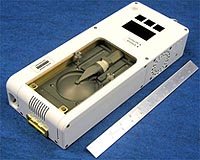 |
Washington (AFP) Jan 14, 2010 Eastman Kodak Co. announced Thursday that it has filed lawsuits against Apple and Blackberry maker Research In Motion alleging they infringed Kodak digital imaging technology. The photography company said it had filed a complaint with the US International Trade Commission claiming that camera-enabled iPhones and Blackberrys infringe a Kodak patent related to an image previewing method. Kodak said it had separately filed two suits against Apple in US District Court in New York claiming infringement of patents related to digital cameras and certain computer processes. "Kodak has a long history of digital imaging innovation and we have invested hundreds of millions of dollars creating our industry-leading patent portfolio," said the company's chief intellectual property officer Laura Quatela. "In the case of Apple and RIM, we've had discussions for years with both companies in an attempt to resolve this issue amicably, and we have not been able to reach a satisfactory agreement," she added in a statement. "There's a basic issue of fairness that needs to be addressed. Those devices use Kodak technology, and we are merely seeking compensation for the use of our technology in their products." Quatela said Kodak decided to take the issue to the courts in order to protect shareholder interest and licensees of the technology. Kodak said it has licensed digital imaging technology to some 30 companies, including LG, Motorola, Nokia, Samsung and Sony Ericsson. "Our primary interest is not to disrupt the availability of any product but to obtain fair compensation for the use of our technology," Quatela said.
Share This Article With Planet Earth
Related Links Computer Chip Architecture, Technology and Manufacture Nano Technology News From SpaceMart.com
 When The Nose Knows All
When The Nose Knows AllPasadena CA (JPL) Jan 12, 2010 Some might say it's as plain as the nose on your face. But detecting toxic or dangerous chemicals in the microgravity environment of space takes a little extra "sniffing." That's why ENose, or Electronic Nose, spent 10 months on the International Space Station testing whether the technology was useful to detect possible hazardous vapors. Managed by NASA's Jet Propulsion Laboratory in ... read more |
|
| The content herein, unless otherwise known to be public domain, are Copyright 1995-2009 - SpaceDaily. AFP and UPI Wire Stories are copyright Agence France-Presse and United Press International. ESA Portal Reports are copyright European Space Agency. All NASA sourced material is public domain. Additional copyrights may apply in whole or part to other bona fide parties. Advertising does not imply endorsement,agreement or approval of any opinions, statements or information provided by SpaceDaily on any Web page published or hosted by SpaceDaily. Privacy Statement |